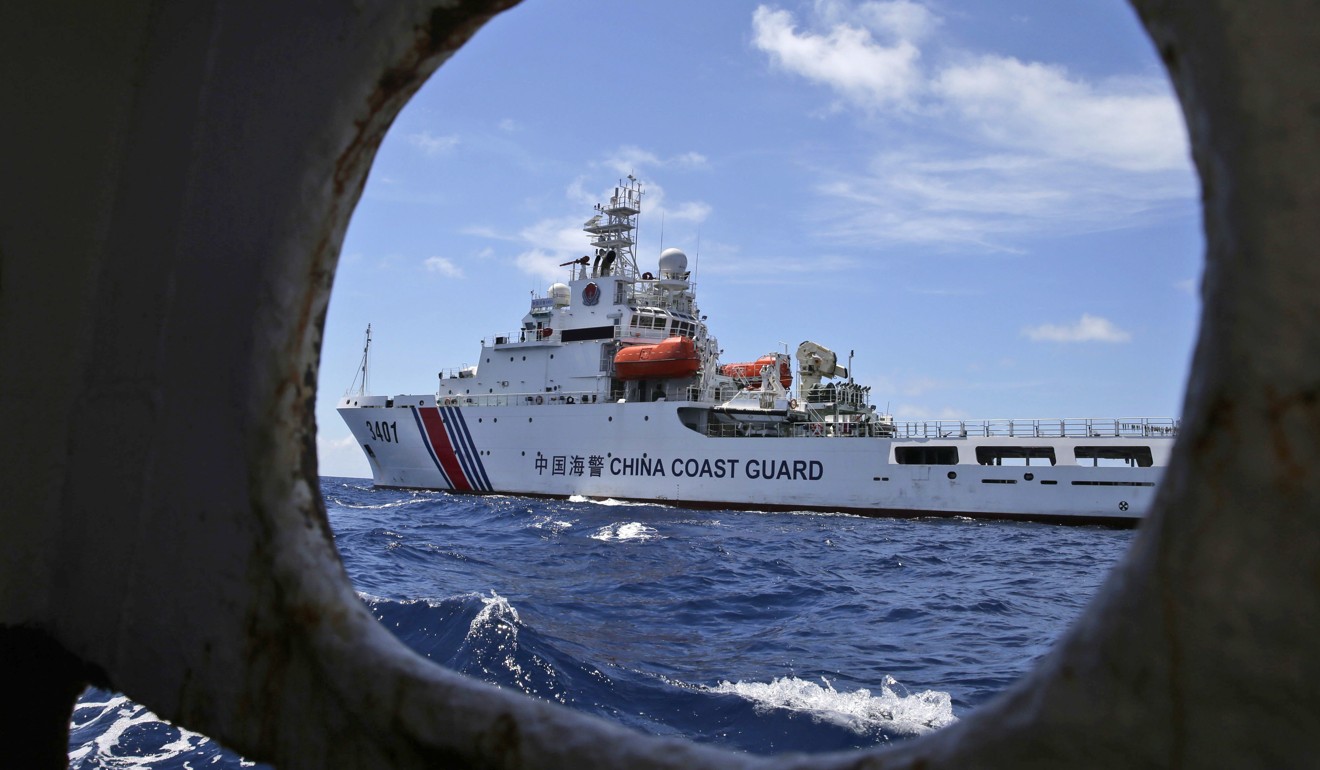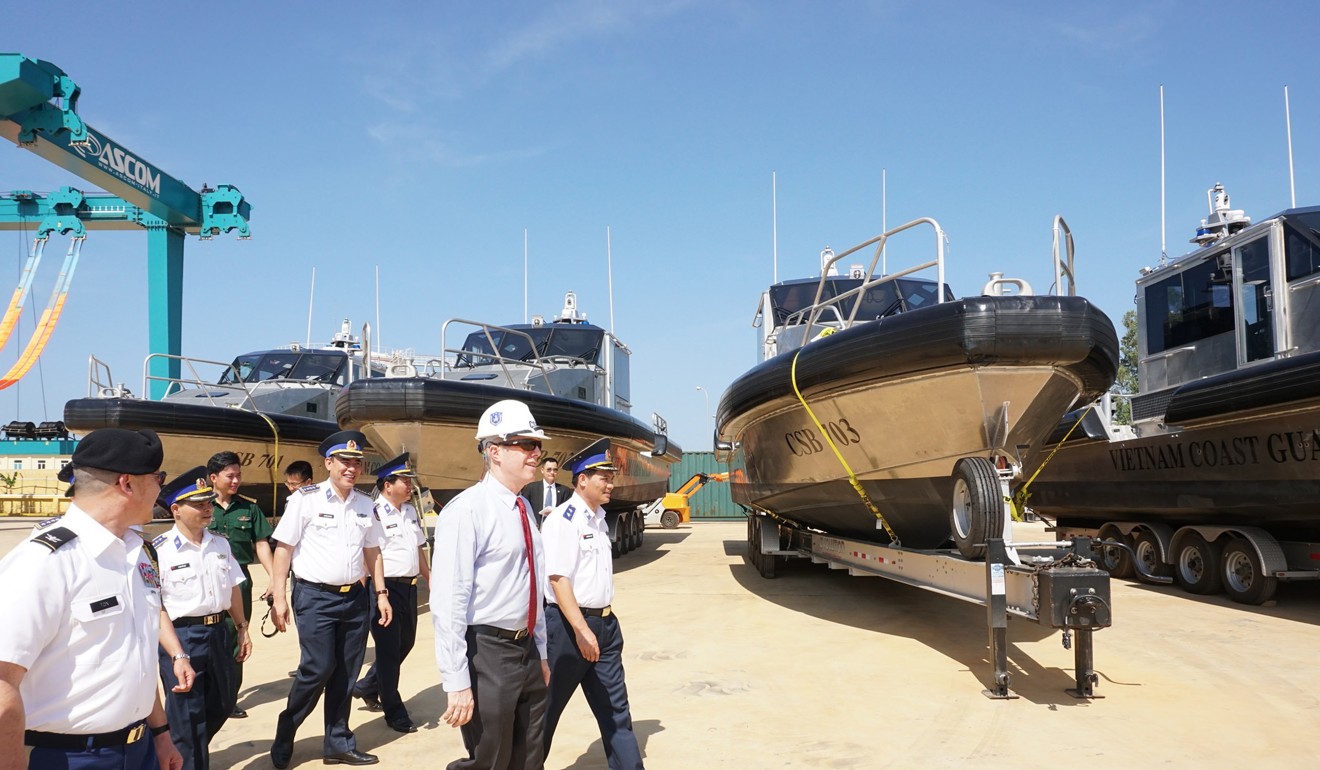
China’s neighbours bolster their coastguards as stand-off stokes tensions in disputed South China Sea
- Philippines and Vietnam moved to empower their coastguards after heavily armed Chinese and Vietnamese coastguard ships began eyeing one another at Vanguard Bank
- Stand-off points to the active role being played by coastguard vessels in Asia’s most complex territorial dispute
China’s neighbours in the South China Sea are racing to empower their coastguard fleets, concerned by Beijing’s increasing use of coastguard ships to boost its sovereignty claims in the disputed waters.
Observers said China’s moves, aimed at advancing its territorial demands without involving its military, could escalate tensions in the maritime region.
On Wednesday, the Philippine Coast Guard announced it would receive a French-made 84-metre (276-foot) offshore patrol vessel, believed to be its “biggest and most modern” patrol ship, in December.
Designed to conduct general coastal patrols of territorial waters as well as law enforcement and maritime surveillance operations, the vessel is expected to handle all maritime security and safety missions in the Philippine archipelago in the South China Sea, according to local media.

Vietnam also passed a law permitting its coastguard fleet to operate outside the country’s territorial waters, sending a signal that Hanoi is likely to deploy ships to expand its presence in the controversial maritime region.
Tensions in the South China Sea have flared up in recent weeks after six heavily armed coastguard vessels – two from China and four from Vietnam – began eyeing each other in patrols around Vanguard Bank in the Spratly Islands.
No reply from Beijing to US call for South China Sea crisis talks
The stand-off, closely monitored by maritime security experts, pointed to the more active role now being played by coastguard vessels, commonly known as “white hulls”, in Asia’s most complex territorial dispute.
Six claimants, including China, four Southeast Asian nations and Taiwan, plus outside powers such as the US and Australia, have demanded freedom of navigation rights in the waterway that carries trillions of dollars of trade.

“The white hull has been more active in the South China Sea [disputes] and its role is becoming more prominent than military forces,” said Zhang Mingliang, an associate professor specialising in South China Sea studies at Jinan University in Guangzhou in southeast China’s Guangdong province.
“Usually more focuses have been placed over the increase of navy powers while the rising number of coastguard capability have been overlooked, but the fact is that while the navy powers are growing, so is the number of coastguard vessels in the region, in a more rapid way,” Zhang said.
China has extensively used its coastguard vessels – more muscularly than most of its neighbours – in the disputed South and East China seas as a way to boost its sovereignty claims without having to involve its military.
In the most high-profile case, Beijing took control of the Scarborough Shoal from Manila in 2012 after a months-long stand-off between fishing boats and coastguard vessels, triggering the worst crisis ever in China-Philippines relations.
Duterte invokes US defence pact over South China Sea row
In 2014, a Chinese coastguard vessel rammed a Vietnamese coastguard ship after a Chinese oil rig had started drilling in the disputed South China Sea. As tensions escalated, anti-China riots broke out in Vietnam.
Regional observers said Beijing’s use of non-military forces, and of coastguard vessels in particular, to reinforce its claims in the South China Sea have “set a lesson” for other claimants, especially those in Southeast Asia, even though funding constraints have limited its efforts.
“In theory, sending coastguards instead of navies would give a less militaristic impression and help promote stability,” said Collin Koh, a research fellow with the Maritime Security Programme at Singapore’s S. Rajaratnam School of International Studies.
“But in reality, as we saw in recent events, the possession of such forces actually incentivises some parties to carry out coercion.”
Despite Philippine President Rodrigo Duterte's pursuit of warmer ties with Beijing, Manila has quietly stepped up its build-up of its coastguard over the past year.
In February, it received two 12-metre-high speed boats from Japan as part of an anti-terrorism package with the country, a traditional maritime power that has long had a dispute with Beijing over uninhabited islands in the East China Sea.
China and Vietnam tread softly in South China Sea over latest dispute
And for the first time in seven years, in May, the Philippine government hosted a visit by a US coastguard cutter, the USCGC Bertholf.
The visiting American ship took part in a military training exercise with two Philippine coastguard vessels to strengthen “search and rescue, maritime security and law enforcement capabilities”.
Koh said that while everyday maritime security and safety issues, including a crackdown on illicit activity, could impel countries in the region to expand their coastguard forces, it was clear that China was the “key driving force”.

“China, Japan and to a lesser extent Vietnam could be more predisposed to [strengthen their coastguard forces] because their coastguards would have a larger pool of offshore-capable assets to deploy,” he said.
But Vietnam, which most loudly opposes China's claims and military build-up in the regional sea, has turned to the US, Japan and South Korea for help building up its coastguard facilities and training coastguard officials, Jinan University’s Zhang said.
Simmering stand-off: China disrupts Malaysia, Vietnam ship exploration
Over the past two years, the US has provided Vietnam’s coastguard with 18 patrol boats and a high-endurance cutter; and Japanese Prime Minister Shinzo Abe has repeatedly pledged to help Vietnam enhance its maritime law enforcement capability with new coastguard vessels.
Zhang said that with more coastguard vessels expected to be deployed to the front lines in the disputes, the risk of dangerous confrontation and conflict could grow, especially since no code of encounter for coastguard ships has been established in the region.
“So far the most common approach [for the countries in the region] is that everyone is racing to buy new boats, like a coastguard vessel race,” Zhang said. “But, because more vessels are involved, it’s now getting more difficult to steer the front-line incidents.”
Koh said that without rules in place to prevent and mitigate the dangers of risky interactions, the disputed waters will become even more problematic as other countries, such as Malaysia and Indonesia, deploy their navies in the area.
In May, a Vietnamese coastguard cutter was accused of ramming an Indonesian navy ship attempting to seize a Vietnamese fishing boat in what Jakarta said was its exclusive economic zone in the South China Sea.
On Monday, Malaysia’s navy conducted anti-ship missile firings – bringing fresh tension to the region – after Chinese coastguard vessels reportedly harassed vessels from Malaysia and Vietnam around Luconia Breakers, a reef cluster at the southern end of the Spratlys, in May.
“The real complexity here is that for the foreseeable future, we will still see navies and coastguards operating in the same space, instead of a purely coastguard-versus-coastguard type of interaction,” Koh said.

